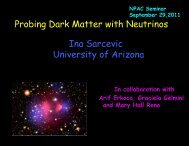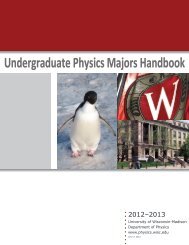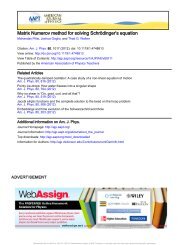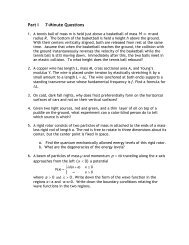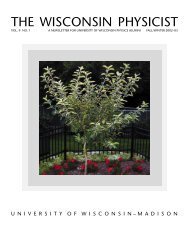T H E W I S C O N S I N P H Y S I C I S T - Department of Physics ...
T H E W I S C O N S I N P H Y S I C I S T - Department of Physics ...
T H E W I S C O N S I N P H Y S I C I S T - Department of Physics ...
Create successful ePaper yourself
Turn your PDF publications into a flip-book with our unique Google optimized e-Paper software.
GREETINGS TO PHYSICS<br />
ALUMS & FRIENDS<br />
Another year has passed and for the <strong>Department</strong>, it has been<br />
busy with the upcoming move and the many decisions that<br />
come with the move. I asked a number <strong>of</strong> people on campus<br />
what they remember most about Sterling Hall and two<br />
Sterling Hall events came to light, which I’ll share with you.<br />
The first is the Sterling Hall bombing, which has become a<br />
legend <strong>of</strong> the University. I was living in Madison in the late<br />
summer <strong>of</strong> 1970 when four young men, known as the New<br />
Year’s Gang, plotted and carried out the bombing <strong>of</strong> the<br />
Army Mathematics Research Center which was located in<br />
Sterling Hall, as a protest to the Vietnam War. Karl<br />
Armstrong came up with the idea and convinced his younger<br />
brother, Dwight, as well as David Fine and Leo Burt, to<br />
participate in the bombing.<br />
Early in the morning hours <strong>of</strong> August 24, 1970, the New<br />
Year’s Gang loaded about 2,000 pounds <strong>of</strong> ammonium<br />
nitrate soaked in aviation fuel into a stolen Ford. The group<br />
parked the van below the Army Mathematics Research<br />
Center, near a driveway in Sterling. At 3:42 a.m. the bomb<br />
exploded. It was powerful enough to knock out windows six<br />
blocks away, and police found pieces <strong>of</strong> the Ford van on top<br />
<strong>of</strong> an eight-story building nearby. Residents <strong>of</strong> Belleville,<br />
thirty miles from Madison, reported hearing echoes from the<br />
explosion. In all, the bomb caused about six million dollars in<br />
damages, but did surprisingly little damage to the Army Math<br />
Research Center. The greatest casualty <strong>of</strong> the bombing was<br />
not the physical damage, but the death <strong>of</strong> Robert Fassnacht.<br />
The New Year’s Gang did not intend to kill anyone and<br />
thought the building would be empty on a Sunday night.<br />
Fassnacht, a physics post doc, however, was working late that<br />
night to finish an experiment. His death left the campus<br />
shaken with grief and three children without a father.<br />
Local video shops still rent the documentary, The War at<br />
Home, which discusses the Sterling Hall bombing.<br />
Additionally, books have been written about the event,<br />
including The Madison Bombing by Michael Morris and Rads<br />
by Tom Bates. The antiwar protests <strong>of</strong> the 60's and 70's have<br />
ended in Madison, but we remember those times.<br />
The second memory <strong>of</strong> Sterling Hall came from an event in<br />
1968, when the body <strong>of</strong> 18-year-old Christine Rothschild was<br />
found behind shrubbery outside <strong>of</strong> Sterling Hall. Christine<br />
entered UW-Madison in 1967 after having graduated from<br />
Senn High School in Chicago, Illinois. Her parents and three<br />
sisters lived in a modest home on Chicago’s North Side,<br />
where her father worked as president <strong>of</strong> a local brokerage<br />
firm. Christine had hopes <strong>of</strong> becoming a journalist after<br />
graduation. She was the first victim <strong>of</strong> the Capital City serial<br />
killer. On a dreary May evening in 1968, a male student<br />
discovered her body. Investigators theorized that Christine<br />
had been killed early that morning while she was out jogging.<br />
The coroner ruled that she had died from at least 12 stab<br />
wounds to the chest. Due to lack <strong>of</strong> leads, and in spite <strong>of</strong> a<br />
$5,000 reward to anyone <strong>of</strong>fering information, her case<br />
ended up as a “cold case” folder.<br />
If you have other Sterling Hall remembrances, please send<br />
them to me and I’ll share them in our next issue. The<br />
remodeling <strong>of</strong> Chamberlin continues on schedule with the<br />
administrative staff scheduled to move in during the first part<br />
<strong>of</strong> December. I want to thank you for your continued<br />
support; please continue to send me your information and<br />
news. I hope you’ll be able to join us for our Chamberlin Hall<br />
Grand Opening Celebration next August 12 and 13, 2005!<br />
Mary Anne Clarke, Editor<br />
(Sterling Hall events taken from www.crime.library.com/<br />
serial_killers/unsolved/madison_wi/1.html &<br />
www.sit.wisc.edu/~psohandbook/odds/bomb/htm)<br />
VIEW FROM THE CHAIR<br />
The past year — my fourth in this term — again went swiftly<br />
by, and there was the usual daunting mix <strong>of</strong> repetition and<br />
novelty. It called to mind a particularly apposite phrase<br />
(borrowed from my friend and colleague Francis Halzen)<br />
“Plus ca change, plus c’est la meme chose.” Things do<br />
change and — surprise!! — after the fact they look much<br />
the same. (At least a few do!)<br />
Illustrative <strong>of</strong> the changes: the long-time Dean <strong>of</strong> the College<br />
<strong>of</strong> Letters and Science, Phillip Certain, retired and, after a<br />
summer <strong>of</strong> searching, Pr<strong>of</strong>essor Gary Sandefur <strong>of</strong> the<br />
Sociology <strong>Department</strong> was<br />
appointed the new Dean.<br />
Dean Sandefur had served<br />
as Interim Provost prior to<br />
the appointment <strong>of</strong> Peter<br />
Spear, so at least he was<br />
familiar with the challenges<br />
accompanying his new<br />
position. Another example<br />
was the retirement <strong>of</strong><br />
Katharine Lyall and the<br />
appointment <strong>of</strong> Kevin Reilly<br />
as the President <strong>of</strong> the<br />
University <strong>of</strong> Wisconsin<br />
System.<br />
Don Reeder<br />
As the Governor and the<br />
Wisconsin Legislature<br />
continue to confront the structural chasms that have<br />
appeared in the state budget, their strategy for funding the<br />
University <strong>of</strong> Wisconsin seems to be to shift from general<br />
state funds to tuition and gifts and grants. We hope this<br />
trend can be arrested, but there are indications that it will<br />
continue, albeit at a slower pace, during the next biennium.<br />
Much <strong>of</strong> the attraction <strong>of</strong> University <strong>of</strong> Wisconsin <strong>Physics</strong><br />
consists <strong>of</strong> the events and opportunities that are funded at<br />
the margin. That is, the state supports only the basic costs<br />
2 U W – M A D I S O N P H Y S I C S


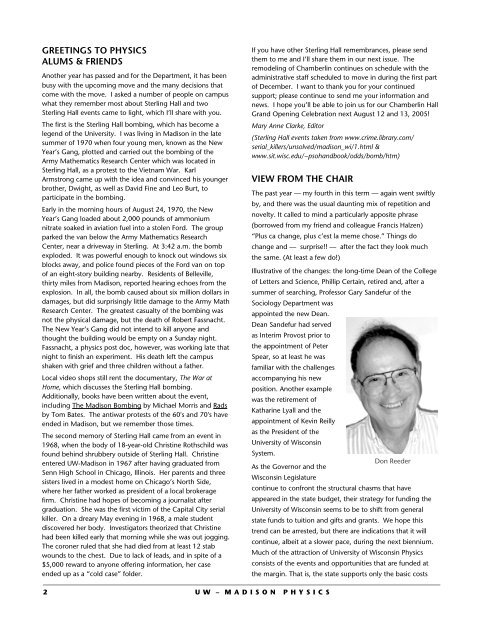

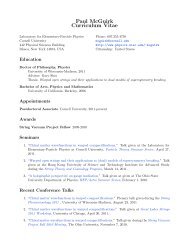
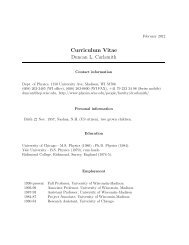
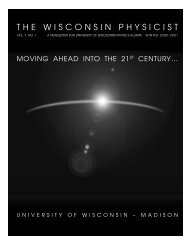
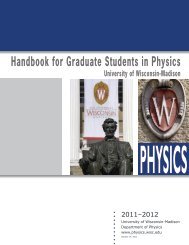


![The Symmetric Linear Potential [ ]](https://img.yumpu.com/25329322/1/190x245/the-symmetric-linear-potential-.jpg?quality=85)
